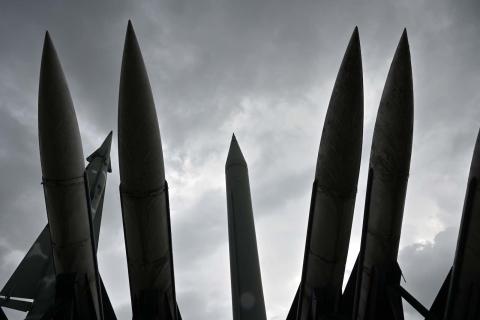The Treaty on the Prohibition of Nuclear Weapons (the ban treaty) was opened for signature on 20 September 2017. The treaty will enter into force when ratified by 50 countries – currently it has 19 ratifications. The International Campaign to Abolish Nuclear Weapons (ICAN) was a major influence behind the negotiation of the ban treaty, and was awarded the 2017 Nobel Peace Prize for its efforts.
The ban treaty has comprehensive aims: to prohibit the use or the threat of use of nuclear weapons, and their development, production and testing; acquisition, possession and stockpiling; transfer; stationing and deployment.
Negotiation of the treaty was prompted by the lack of progress in nuclear disarmament. Not only are the nuclear-weapon states failing to honour their obligation in the Nuclear Non-Proliferation Treaty (NPT) to pursue disarmament negotiations, but current nuclear weapon “modernisation” programs risk starting a new arms race.
Encouraged by the achievement of ban treaties for chemical and biological weapons and land mines, the proponents of this treaty hope that mobilising global support could lead to a similar outcome for nuclear weapons. There is, however, a fundamental difference – in the case of these other weapons, the major possessor countries concluded they were not essential to their national security.
This is not the case with nuclear weapons. All the nuclear-armed countries believe they need nuclear weapons to deter nuclear attack, and have yet to find a disarmament pathway that will meet their security concerns.
Paradoxically, in a ‘nuclear-free’ world, the motivation for a country to pursue nuclear weapons could be even greater.
The ban treaty proponents were looking for a quick outcome and decided against seeking an inclusive approach with the nuclear-armed countries, which would require a sustained effort over many years. Realistically, however, nuclear disarmament cannot be imposed. Nuclear weapons can be eliminated only with the agreement of the nuclear-armed countries.
Regrettably the ban treaty has proven highly contentious. Not only are none of the nuclear-armed countries prepared to join, the treaty text has serious substantive problems, likely to damage rather than advance the goal of disarmament. These include weak safeguards (verification) provisions, uncertain impact on existing treaties such as the NPT and the Comprehensive Nuclear-Test-Ban Treaty (CTBT), and uncertain implications for defence alliances.
On safeguards, the ban treaty undermines the requirement, unanimously endorsed by NPT Review Conferences, for the highest safeguards standard – currently the International Atomic Energy Agency’s “additional protocol” – to apply to all countries. The universal application of the highest safeguards standard is essential, because the nuclear-armed countries will not disarm if they believe new nuclear-armed states could emerge.
Paradoxically, in a “nuclear-free” world the motivation for a country to pursue nuclear weapons could be even greater, hence the need for stronger, not weaker, safeguards.
Regarding defence alliances, the treaty prohibits parties from assisting, encouraging or inducing, in any way, anyone to engage in any activity prohibited under the treaty. This could be interpreted as prohibiting any defence cooperation with a nuclear-armed ally. This was one reason why most countries in defence alliances, including NATO members, Australia, Japan and South Korea, did not join the treaty negotiations.
To date, adherence to the ban treaty has been slow. During the negotiations 122 countries voted in support of the treaty. So far, a year after the treaty opened for signature, barely half these countries have signed the treaty, and just over a quarter of the signatories have ratified. It seems many that voted for the treaty are now hesitant, perhaps because of greater awareness of the problems with the treaty – see the critique by Switzerland, which voted for the treaty but has not joined it.
Currently ICAN has an international campaign for parliamentarians to sign a pledge urging governments to join the treaty. At the time of writing, over 160 Australian federal, state and territory parliamentarians had signed this pledge. It is perfectly understandable for people to sign for the elimination of nuclear weapons, but it must be asked, how many have actually read the treaty, and how many are aware of the problems with the treaty’s provisions?
For all its faults, the ban treaty has served to focus renewed attention on the lack of any commitment by the nuclear-armed countries to pursue nuclear disarmament, and the need to do something about this. The question is: what to do?
Delegitimising nuclear weapons, as the treaty seeks to do, is an important step in changing mindsets about these weapons, but much more is required. The reality is there is no substitute for a carefully negotiated step-by-step approach, looking at concrete actions such as:
- risk reduction steps, such as de-alerting and no-first-use policies
- progressive reductions in weapon numbers
- critical analysis of the rationale for nuclear deterrence
- ending “modernisation” programs
- transparency and other confidence-building measures.
These and other actions are outlined in the 2009 report of the International Commission on Nuclear Non-proliferation and Disarmament. What is needed now is to instil a sense of common purpose and urgency in political leaders, to commence negotiations to achieve substantive steps.
Those that reject the ban treaty have a responsibility to produce something better.

